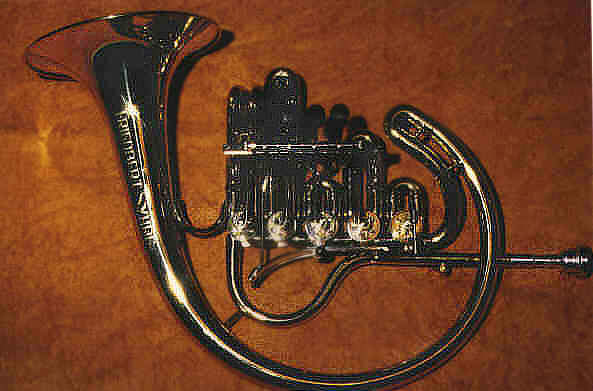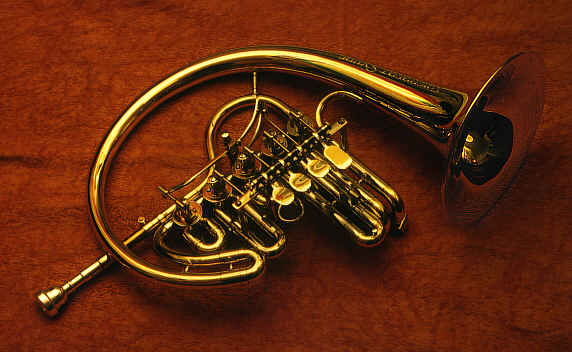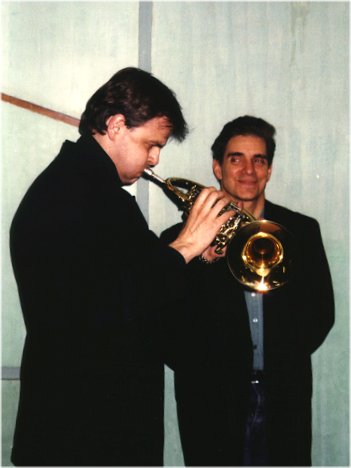Corno da Caccia
The corno da caccia (horn of hunting) was one of the most famous brass
instruments at the beginning of the 18th century, because it was "not so
hard in nature as the trumpet" and "could be played with greatest facility".
The horn had developed from an hunting-signal instrument to one of
virtuosity. Therefore a lot of concertos were composed for corno da caccia
in this period which are hardly playable on french horns (as built since
the 19th century) because of their high pitch. It's almost the same for
horn phrases in several cantatas of J.S. Bach.

The following points describe the characteristics of this instrument:
-
First, the "entry" into the instrument from the mouthpiece shank is at
the 4th valve and not like most other brass instruments at the 1st valve.
-
The connections between the valves are conical and not cylindrical like
all other brass instruments.
-
The "exit" at the 5th valve leads to a bow, and the whole rest of the instruments
widens up to the bell. Other instrument widen only at the very last part
before the bell.
-
The corno da caccia is available either right or left handed, with trumpet
or horn shank. Also, the number and type of valves are individual choices.
-
The range relates to the ability of the player, but is generally near to
that of a trumpet. Thanks to an additional valve (f-attachment) almost
another octave can be reach in the low range; most trumpeters find this
very interesting.
-
The sound is not comparable to other brass instruments. On one hand, it
has the softness and greatness of the flugelhorn; on the other hand, it's
as clear and brilliant as a trumpet.

 ...
a little example ...
...
a little example ...  ( 19.98 sec, 431 KB )
( 19.98 sec, 431 KB )
Today only drawings and building instructions are available for historic
instruments. It was the German trumpeter Ludwig Güttler who found
important compositions of the Baroque in libraries and looked for a way
to make them sound again in modern concert halls. For this purpose he inspired
the instrument maker Friedbert Syhre from Leipzig, Germany, to create a
valve- corno da caccia, whose timbre equals the historic horns. With this
instrument and its successor, Güttler successfully started the revival
of virtuosos playing on clarin horns.

The instrument you see here is a corno da caccia according to Güttler's
latest findings. It was built in 1996 to match my own requirements. The
only difference to Güttler's instrument is the 5th valve, which tunes
his horn to Eb but mine to A. This change can be redone any time with the
use of different mouthpiece shanks and tuning slides. It also has a 4th
valve built as f-attachment and a trigger for the 3rd valve. While being
played, the instrument rests on the left hand, the left thumb works the
trigger and the 5th valve. The thumb of the right hand also holds the horn,
and the right fingers work the other four valves. The instrument is of
lacquered brass with inlays of silver. Shortly before it was finished,
the position of the 5th valve was changed, because Güttler experienced
balance problems. Therefore, this instrument is the latest release of a
historic instrument.
The bell size is of free choice. Güttler suggests a diameter of
12 to 22 cm (4.72" - 8.66"). The wider the bell the smoother the sound,
but the tone will become less stable in higher ranges and is more difficult
to play. In contrast, you'll have problems to reach the interesting lower
ranges with a small bell. The bell diameter of this instrument. therefore,
is a suggested medium size of 16,7 cm (6.57"). Güttler recommends
a wide mouthpiece with big boring. The instrument can be safely transported
with a special gig bag.
 My friends Jens Lindemann and David Ohanian of
The Canadian Brass
are enthusiastic about my Corno da caccia !
....... me too !!!!
For your questions.
My friends Jens Lindemann and David Ohanian of
The Canadian Brass
are enthusiastic about my Corno da caccia !
....... me too !!!!
For your questions.  This page hosted by
This page hosted by  Get your own Free Home Page
Get your own Free Home Page



